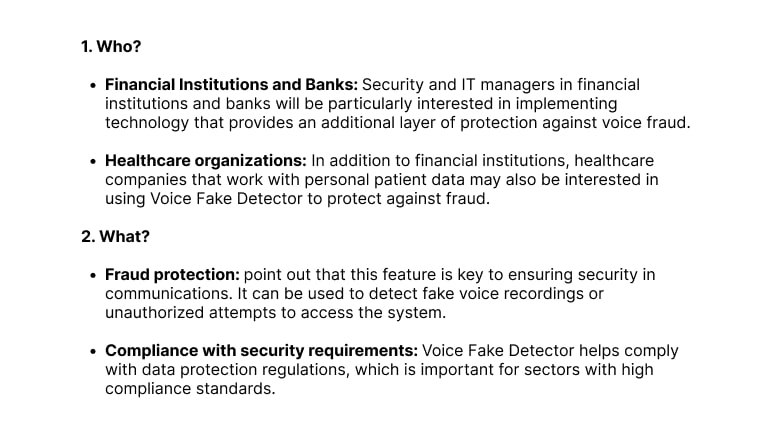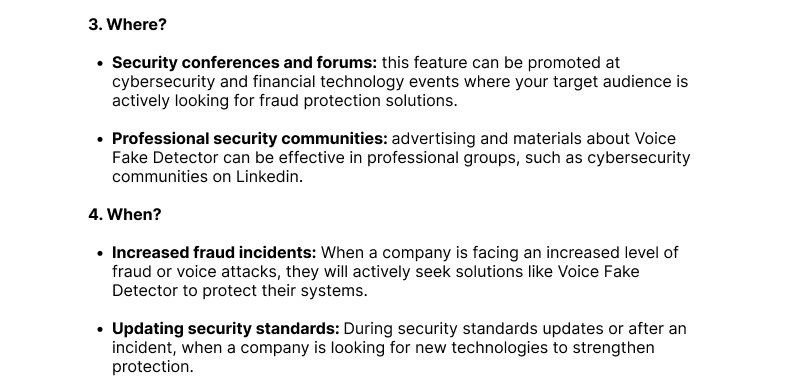Imagine this: you’ve created a powerful tech product for the local market — a platform for corporate communication — and you realize it’s time to scale. But a new challenge lies ahead.
The client came to us with a clear goal: to identify the strengths and weaknesses of the project’s marketing in Ukraine and to develop a marketing strategy for entering the UK market. The objective was to attract investment for the project’s growth, which required a structured development plan with clear stages and well-reasoned decisions.
We got to work. A deep analysis of the market, competitors, target audience, and positioning — everything needed to ensure the strategy would be not only effective on paper but also executable in the real world.
The client came to us with a request to enter the UK market. But what happened next — and how did it change the scope of work? We’ll tell you now!
How can a marketing strategy help secure investment?
When you’re preparing to apply or pitch your project to investors, it’s important to have more than just an idea — you need a well-founded strategy backed by data and insights.
We don’t just help with all the necessary calculations — we also prepare the materials for your investor presentations. So, if you’re planning to raise investment, we’re ready to support you with a consultation.
| How much time did it take to develop the strategy? | 80 hours, 4 working weeks |
| Who was involved in developing the marketing strategy? | Head of Marketing Team, Head of PM Team, Operational Marketer, Head of Content Team, Content Marketer, Head of PPC, PPC Facebook |
| How were the results used? | Implemented by Solve Marketing |
Let’s Get Acquainted
IPTel is a communications, automation, and sales platform that quickly adapts to your business needs. What makes it different?
- A comprehensive communication system: call center, auto-dialing, CRM, contact center.
- Strong tech support.
- Affordable pricing.
- The first integrators of artificial voice detection systems.
- 500+ completed projects.
- Communication, sales, and automation — all in one space.
Since the project currently operates in the Ukrainian market, our research began there. Cloud telephony is gaining momentum in Ukraine: in 2023, the electronic communications market grew by 17% and reached ₴97.3 billion. Businesses are seeking ways to optimize their operations, and cloud contact centers are the ideal solution — enabling automation, cost savings, and improved customer service.
But challenges remain: talent shortages, the need for innovation, war, and international expansion. Technology helps businesses adapt, and investors are increasingly putting their money in electronic communications. Key trends: artificial intelligence, analytics, mobility, and cybersecurity.
United Kingdom: a new market, new challenges
Next, we analyzed the UK market and realized it’s like a crwded London pub on a Friday night — noisy, packed, and everyone’s fighting for attention.
CCaaS Market Valuation Correlation in Europe:
| Year 2023 | Year 2032 |
| $1.49 billion | $8.03 billion |
How does the UK market differ from Ukraine?
- Market maturity level — in the UK, companies are already actively using cloud solutions.
- Focus on automation and AI — British companies are ready to invest in AI and predictive analytics.
- Strict security requirements — due to high fraud risks.
- High competition.
What could become the “golden key” for IPTel? We found the answer while creating the marketing strategy.
Entering this market is a challenge, but also a great opportunity. Therefore, the task of our marketing strategy was not only to appeal with strong arguments to attract investment. During the research process, we evaluated whether it was worth entering the UK market specifically.
It is important at the start to deeply understand the specifics of the particular project. And this is where detailed interviews and briefs with owners help us synchronize with the real business needs
Competitor analysis: strengths and weaknesses
Entering a new market — is a deep strategic effort that begins with competitor analysis.
It turned out that the market is already occupied by international giants (8×8, Ringover, Aircall), which have strong marketing and massive resources.
There are also local solutions (Vonage, Acefone) that are well adapted to the UK market but do not offer unique technologies. Separately, there are niche players — small companies competing on price and customization
We noticed that none of the competitors offered a built-in voice deepfake detection system. And this became our main competitive advantage.
Moreover, the number of fraud cases through deepfake calls is increasing in the UK, and banks, insurance companies, and financial institutions are seeking solutions.
To conduct a detailed analysis, we looked at several aspects:
- Products and unique capabilities.
- Pricing policy — what service packages are available on the market.
- UX/UI and websites — what the products look like, and whether they are user-friendly.
- Marketing strategies — which promotion channels companies use.
- Customer service and reputation, user reviews.
We thoroughly analyzed the competitors and found their weak points — even among the strongest players. For example, 8×8 is a major brand but lacks a free trial period. Binotell is a strong player in Ukraine but has no AI functionality.
All the gathered information was structured into a detailed comparison table that helped to:
+ Evaluate competitors’ strengths and weaknesses.
+ Identify market gaps.
+ Develop a marketing strategy based on real data
Part of the table:

Based on the competitor analysis, we identified market trends, leaders, and the weak spots of players that can be leveraged in the strategy. We also gathered analytics and examples of advertising campaigns that support the conclusions and help shape a promotional plan.
First date with IPTel
The first visit to a website is like a first date: it should be easy, clear, and engaging — so the user wants to come back.
So what did we see when analyzing IPTel’s websites?
The Ukrainian version, iptel.ua, and the English version, iptel-dialer.com, looked more like a detailed technical manual than a convenient commercial website. There was a lot of information, everything was explained — but are users really willing to spend time reading long instructions? Unlikely.
The Ukrainian version had an outdated design, lacking modern elements: animations, interactive blocks, ease of perception. On mobile, things were even worse: slow performance, confusing navigation, hidden CTA buttons that, instead of drawing attention, got lost among other elements.
This was just part of what needed to change.
The second website, targeting the UK market, also failed to make the right impression. British audiences expect short, clear messages and a well-structured visual layout, but they were met with a long, complex story with no obvious benefits.
The solution? Simplification. Less text, more visuals, clear CTA buttons, and fast mobile loading. This kind of approach will hook the user from the very first second.
What about social media?
IPTel was present on social media, but without active engagement. And in today’s world, it’s not just a news showcase — it’s a powerful tool for customer engagement and lead generation.
What’s needed?
🔹 Revive activity by developing an SMM strategy that aligns with project goals and market trends.
🔹 Create content that not only informs but also engages the audience.
🔹 For the international market — separate profiles adapted to the culture, language, and mindset of the target audience.
During competitor analysis, we dive into their communication to understand how, when, and why they interact with their audience. We explore which tactics deliver results, what works best, and what doesn’t.
Because effective SMM is a clear strategy based on deep analysis, real data, and proven methods. Only this way can you build a strong and recognizable social media presence that truly delivers results.
“Mystery Shopper”: undercover mission
How can you understand if a service is performing at its best? The best way — is to test it through the eyes of a real customer. But not just any customer — a professional mystery shopper. This is a method we use at Solve Marketing as part of a deep analysis of service quality and competitiveness.After a comprehensive study of IPTel and its competitive environment, we developed personalized test scenarios.
We created realistic interaction scripts: our agents contacted support, ordered product demos, and evaluated the quality of consultations, response times, and the convenience of the processes.
We became real customers.
Each step was carefully documented: call recordings, chat screenshots. We experienced all the emotions of real users — from the first contact to the final impression.
But our mission had only just begun.
To get a full picture of the market, we carried out a similar “reconnaissance” on IPTel’s competitors. We found out what they do better, where their weak points are, how they retain customers, and which unique features they use.
This allowed us to form a complete understanding of the market and develop unique recommendations to improve IPTel’s service.
Let’s check if your service leaves the right impression.
Operation result
We compiled the collected data into a detailed report with specific recommendations. IPTel received not just an overview of the current level of service, but a clear improvement plan:
- How can the communication process be optimized?
- What should be implemented to outperform competitors?
- Where are the biggest pain points in customer interaction?
Do you know how your company looks through the eyes of a customer?
Because the real path to perfect service begins with an honest look at yourself.
What influences a customer’s decision?
Why does a customer choose your company, your product, or your service?
And what makes them come back again? These are the questions that define business success.
The list of choice factors looks something like this:

We gathered 120+ factors that include not only IPTel’s attributes but also those of competitors — which can serve as development potential.
During the analysis, we identified around 120 choice factors, each of which should be turned into a task and implemented within the project.But it’s important not to expect that just 1–2 factors will significantly impact the result.
The more factors you implement, the more comprehensive the effect — and the more noticeable the increase in the number of clients.Thanks to these choice factors, we determine what and how to communicate with clients, develop a strategic growth plan, highlight strengths, and define development vectors that match the specific needs of the business
SWOT Analysis: A Strategic View of the Company
To dive even deeper into the competitive environment, we conducted a SWOT analysis — a method that helps assess the company’s strengths and weaknesses, as well as uncover opportunities and threats.
We clearly identified the strengths, such as the solution’s comprehensiveness and the unique functionality of the Voice Fake Detector, and the weaknesses, including low brand awareness and the absence of a mobile app.
This allowed us to focus our efforts on leveraging opportunities (e.g., WhatsApp integration, listings on popular platforms, and building a partner network) and minimizing threats.Thus, the analysis of choice factors and the SWOT provided a clear understanding of the company’s strategic direction.
We now know exactly which advantages to amplify and which barriers to overcome.
Who are they — our target audience?
To hit the mark with communication and offerings, it’s crucial to clearly understand who our client is. That’s why we conducted deep segmentation using the “5W” method, identifying the main audiences:
- Heads of Sales Departments.
- Heads of IT Departments.
- Business Owners
Key sectors: financial sector, medical companies, outsourcing contact centers, and several others.
This enables us not just to form a general customer profile, but to create targeted advertising and content messages for specific decision-makers.
Here’s an example of one of the segments:
How did we create the positioning?
Positioning is not just a slogan. It’s what makes a brand unique and memorable to clients. It must work everywhere — on the website, in social media, during sales — but most importantly, it must be approved by the company itself and embedded in every process.
We developed three positioning concepts for IPTel: Technological Advantage,
Leadership, Industry Specialization.
The key highlight became the Voice Fake Detector — a technology that protects against voice fraud.
It allowed us to build the positioning around data security, which is critically important for banks and medical institutions.
Every step of research — competitor positioning, choice factors, market analysis — was the key to finding the most effective positioning.
We went through several iterations to develop different concepts and, together with the client, selected the best version from the possible options.
We always look for existing uniqueness — not something made up. Because that’s what positioning really is: expressing your most unique and real factors in a single phrase that resonates with your clients.
The final version we approved with the client:
IPTel — a communications, automation, and sales platform that quickly adapts to your business needs.⬇️
In one phrase, we included essential factors:
+Voice security: AI to fight fraud.
+Flexibility and scalability: easily adapts to your business
+All-in-one space: sales, support, automation.
+Fast start: minimum time to launch.
Do you have a clear positioning that will immediately tell clients why they should choose you and how you can help them?
We will be happy to develop your unique positioning!
Marketing hypotheses for testing
We developed hypotheses to test effective ways of attracting clients and increasing conversions, based on market and competitor analysis.
📌 Lead magnet on the website as a lead generator
What if we offer a free, valuable resource (a checklist, guide, webinar) in exchange for contact information? We’ll test how this affects the attraction of potential customers.
📌 Partnership collaborations as a new lead channel
If we join forces with companies that target the same audience but aren’t competitors, we can generate an additional stream of leads. We’ll test this model through joint webinars, bundled products, or referral programs.
We are building a marketing system: testing hypotheses, analyzing results, and adjusting the strategy based on market changes.
So, thanks to a comprehensive approach, in-depth analysis, and a well-crafted strategy, IPTel has received a clear roadmap for successful entry and scaling in the UK market.
Conclusions:
The result was a comprehensive strategy that enabled IPTel to prepare for a full-scale launch in the UK and laid the foundation for further international scaling.
We developed:
✅ In-depth analysis of the market, competitors, social media, and websites.
✅ “Mystery shopper” research.
✅ Niche positioning.
✅ Marketing hypotheses.
This is what work looks like when it starts with a single task and evolves into a large-scale collaboration. The key is to stay flexible and always keep the big picture in mind.
Even before finalizing the marketing strategy, we had already begun collaborating as a full-fledged marketing department for IPTel — more details on that here.
Want to enter the international market but don’t know how? Book a consultation — and together, we’ll find your unique international expansion strategy based on facts, not assumptions.







